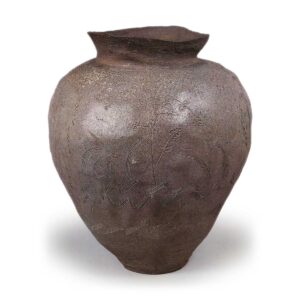
Excavated from Teraya, Suzu City, Ishikawa Prefecture
13th century
Extant height 28.2cm, extant neck diameter 15.0cm, body diameter 26.7cm, bottom diameter 8.5cm
Ishikawa Prefectural Museum of History
This vase was discovered during civil engineering work, and although the mouth and neck had already been lost, the body from the neck down remains in perfect condition. It is a medium-sized jar with rounded shoulders and a small base, and was made in the first half of the 13th century.
The entire surface of the vessel is marked with rubbing marks from grinding and adjustment, and it retains the unevenness caused by the pressure during the molding process.
The design on the vessel’s surface consists of a three-stripe comb-shaped wavy pattern on the lower half of the body, and painted designs on four sides of the body using a four-part technique. On one side, a tree trunk bends vertically using a comb-like tool, and the upper part is bent to the right, and five to six branches hang down from the tree trunk on each side using a narrow comb. At the ends of the branches are a series of leaves divided alternately to the left and right using the stabbing technique, suggesting that the work depicts a willow tree.
The left side of the figure depicts the trunk of a willow tree using a wide comb, and then outlines the trunk using thin lines to trace both sides of the comb pattern, with the tip of the comb bent to the left and right. The branches that branch out from the trunk are also bent, with elliptical leaves in the middle and 10 or so inflorescences at the tip using the prick method. It is difficult to determine the species of this tree, but when considered in combination with the willow tree mentioned above, the design is similar to that on the National Treasure Atsumi jar with the design of autumn grasses, which could also be considered cherry blossoms, although there is a difference between the willow and the comb. The design on the other two sides of the jar depicts a glowing glaze that flutters in the wind. The space between the four sides of the jar is filled with grass patterns. Although this inscription is generally known as an autumn grass motif, the two sides show spring scenes, and it is thought that the purpose of this painting was to depict the four seasons.
Considering the above, it is unlikely that paintings with similar compositions were created by chance in the far-flung regions of Atsumi and Suzu, and it can be assumed that the aristocratic local lords, who were deeply involved in central culture, copied the Yamato-e style popular at the time onto pottery and had it shipped to them for tribute.



